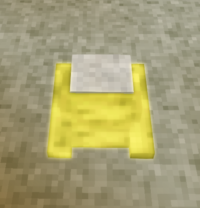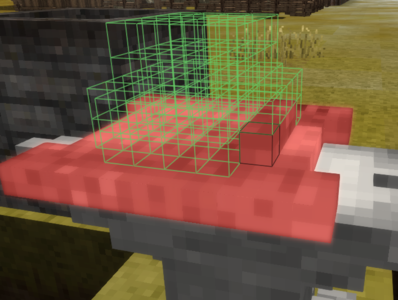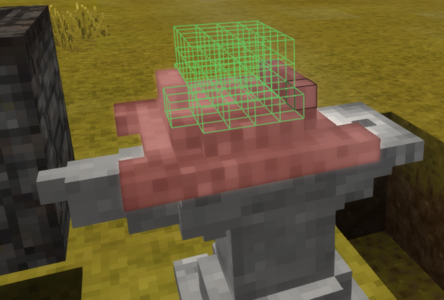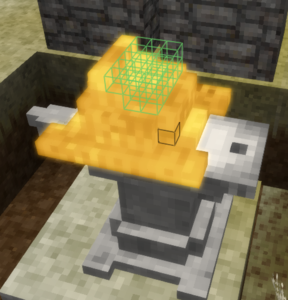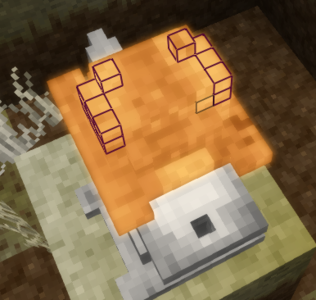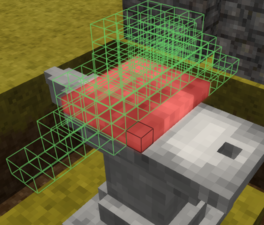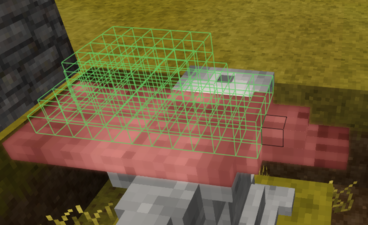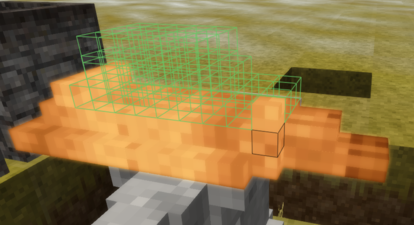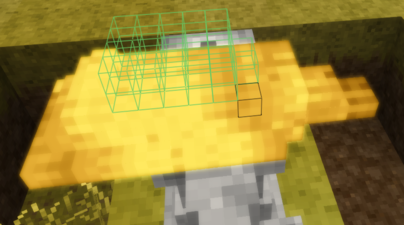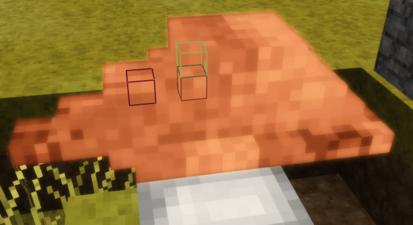Anvil/de: Difference between revisions
(Übersetzung) |
(Updating to match new version of source page) |
||
| (30 intermediate revisions by 5 users not shown) | |||
| Line 1: | Line 1: | ||
<languages /> | <languages /> | ||
{{GameVersion|1.18.15}} | |||
{{Block | {{Block | ||
|Name = Amboss | |Name = Amboss | ||
|Image = File:Grid Copper anvil.png | |Image = File:Grid Copper anvil.png | ||
| | |Stackable = Nein | ||
|Material = | |Material = Metalle | ||
|Drops = | |Drops = sich Selbst | ||
|FloatRight=yes | |||
|NoBreak=yes | |||
}} | }} | ||
<div class="mw-translate-fuzzy"> | |||
Ambosse sind funktionale Blöcke, die beim {{ll|smithing|Schmieden}} von Metall als Oberfläche genutzt werden. | |||
</div> | |||
__TOC__ | __TOC__ | ||
<div class="mw-translate-fuzzy"> | |||
== Herstellung == | |||
===Kupfer und Bronze Amboss=== | |||
Der erste Schritt in diesem Prozess ist, eine {{ll|Molds|Ambossform}} mit Hilfe der Methode des {{ll|Clay Forming|Lehmformens}} herszustellen. Der Amboss wird dann {{ll|casting|gegossen}}. Ein Amboss benötigt 900 Einheiten (9 Barren) Kupfer oder Bronzelegierung, um die Form zu füllen. Sobald ein Amboss gegossen und aus der Form entfernt wurde, kann er wie jeder andere Block auf einer festen Oberfläche platziert werden. Es wir kein Werkzeug benötigt, um den Amboss {{Breaking|aufzunehmen}} und neu zu positionieren. | |||
</div> | |||
<div lang="en" dir="ltr" class="mw-content-ltr"> | |||
In the game, you will need a Tier (n-1) anvil to work Tier (n) materials, i.e. you will need a bronze (Tier 2) anvil to work iron (Tier 3) ingots. | |||
</div> | |||
== | <div lang="en" dir="ltr" class="mw-content-ltr"> | ||
===Copper (Tier 1) and Bronze (Tier 2) Anvil=== | |||
</div> | |||
<div lang="en" dir="ltr" class="mw-content-ltr"> | |||
The first step in this process is to create an {{ll|Molds|anvil mold}} via the {{ll|Clay Forming|clay forming}} mechanic. The anvil is then cast using the {{ll|casting|casting}} mechanic. An anvil requires 900 units (9 ingots-worth) of copper or bronze alloy to fill the mold. Once an anvil is cast and removed from the mold, it may be placed like any other block onto a solid surface. No tools are required to {{Breaking|break}} an anvil to pick it up and re-position it. | |||
</div> | |||
<div class="mw-translate-fuzzy"> | |||
=== Amboss aus Eisen und Meteoreisen === | === Amboss aus Eisen und Meteoreisen === | ||
[[File:Anvil welding.PNG|thumb|200px|Ein Eisenambossbasis mit aufgebrachtem Borax und fehlendem oberen Teil.]] | [[File:Anvil welding.PNG|thumb|200px|Ein Eisenambossbasis mit aufgebrachtem Borax und fehlendem oberen Teil.]] | ||
| Line 20: | Line 42: | ||
<br> | <br> | ||
Um einen kompletten Eisenamboss herzustellen, werden insgesamt 10 Eisenbarren benötigt (je 5 Barren für Ober- und Unterteil) sowie einmal Boraxpulver. Ein Barren ergibt 42 zusätzliche Pixel. Das Ober- und Unterteil des Ambosses benötigen 210 respektive 196 Pixel. | Um einen kompletten Eisenamboss herzustellen, werden insgesamt 10 Eisenbarren benötigt (je 5 Barren für Ober- und Unterteil) sowie einmal Boraxpulver. Ein Barren ergibt 42 zusätzliche Pixel. Das Ober- und Unterteil des Ambosses benötigen 210 respektive 196 Pixel. | ||
</div> | |||
<div lang="en" dir="ltr" class="mw-content-ltr"> | |||
[[File:Anvil welding.PNG|thumb|200px|An iron anvil base with applied borax waiting for the top part.]] | |||
Anvils made out of iron or meteoric iron cannot be cast in molds like copper and bronze anvils, since iron and meteoric iron cannot be melted in a crucible. The player first has to make the upper and lower parts of the anvil separately, smithing them with any {{ll|hammer|hammer}} on a bronze anvil. Then, the two parts need to be welded together with powdered {{ll|borax|borax}}. | |||
</div> | |||
<div lang="en" dir="ltr" class="mw-content-ltr"> | |||
To make a complete iron anvil, a total of 10 iron ingots are needed, 5 each for the anvil base and anvil top, as well as one powdered borax. One ingot amounts to 42 voxels added, and the anvil base and top need 196 and 210 voxels respectively. | |||
</div> | |||
{{Protip | {{Protip | ||
| Line 25: | Line 57: | ||
}} | }} | ||
<div class="mw-translate-fuzzy"> | |||
==== Ambossbasis ==== | ==== Ambossbasis ==== | ||
Beginne den Herstellungsprozess, indem du einen erhitzten Eisenbarren auf dem Amboss (Bronze oder höherstufig) platzierst. Wähle die Ambossbasis und beginne zu hämmern. Beachte, dass für die Basis insgesamt 5 Barren nötig werden und nur Raum für Fehler von 14 Pixeln besteht. Dieser Prozess kann leichter sein, wenn mit einer Eisenplatte begonnen wird und dann nacheinander 3 weitere Barren hinzugefügt werden.<br> | Beginne den Herstellungsprozess, indem du einen erhitzten Eisenbarren auf dem Amboss (Bronze oder höherstufig) platzierst. Wähle die Ambossbasis und beginne zu hämmern. Beachte, dass für die Basis insgesamt 5 Barren nötig werden und nur Raum für Fehler von 14 Pixeln besteht. Dieser Prozess kann leichter sein, wenn mit einer Eisenplatte begonnen wird und dann nacheinander 3 weitere Barren hinzugefügt werden.<br> | ||
Um die Gefahr der Verschwendung von Pixeln (und damit Barren) zu reduzieren, muss nach dem Hinzufügen eines Barrens dieser zuerst geschmiedet werden, bevor der nächste Barren folgt usw. Der Punkt, an dem der nächste Barren hinzugefügt wird, ist immer der gleiche. Daher kann der Spieler sicherstellen, dass dieser Bereich eben und unterhalb der maximalen Höhe des Rezeptes bleibt (6 Pixel bzw. 3 gestapelte Barren). Behalte im Kopf, dass ein neuer Barren nur die leeren Pixel an der genannten Stelle ausfüllt. Daher empfiehlt es sich, diesen Bereich so eben wie möglich zu halten. Der Barren wird auf die gewählte Fläche oben aufgesetzt, sodass der gesamte Bereich "anwächst".<br><br> | Um die Gefahr der Verschwendung von Pixeln (und damit Barren) zu reduzieren, muss nach dem Hinzufügen eines Barrens dieser zuerst geschmiedet werden, bevor der nächste Barren folgt usw. Der Punkt, an dem der nächste Barren hinzugefügt wird, ist immer der gleiche. Daher kann der Spieler sicherstellen, dass dieser Bereich eben und unterhalb der maximalen Höhe des Rezeptes bleibt (6 Pixel bzw. 3 gestapelte Barren). Behalte im Kopf, dass ein neuer Barren nur die leeren Pixel an der genannten Stelle ausfüllt. Daher empfiehlt es sich, diesen Bereich so eben wie möglich zu halten. Der Barren wird auf die gewählte Fläche oben aufgesetzt, sodass der gesamte Bereich "anwächst".<br><br> | ||
Ein optimaler Weg des Schmiedens kann unten angesehen werden, wobei der Fokus darauf liegen sollte, dass die "Landefläche" des Barren so leer und eben ist wie möglich. Denk daran, dass dies der beste Weg ist, um Eisenbarren zu sparen, aber nicht um Kohle zu sparen. | Ein optimaler Weg des Schmiedens kann unten angesehen werden, wobei der Fokus darauf liegen sollte, dass die "Landefläche" des Barren so leer und eben ist wie möglich. Denk daran, dass dies der beste Weg ist, um Eisenbarren zu sparen, aber nicht um Kohle zu sparen. | ||
</div> | |||
<div lang="en" dir="ltr" class="mw-content-ltr"> | |||
Start the crafting process by placing a heated iron ingot on the anvil - bronze or higher anvil tier is needed. Select the anvil base and start hammering. Note that for the base, a total of 5 ingots need to be added, and there is at maximum 14 voxels worth room for error. This process might be easier when starting with one iron plate as the base, and then adding 3 more ingots, one at a time.<br> | |||
To lessen the chance of wasting voxels - and thus ingots - it is necessary to add one ingot, flatten it out and only then add the next - and so forth. The space on which the next ingot will be added is always the same, and the player can make sure that this space is flat and below the maximum height limit of the recipe, which is 6 voxels, or 3 ingots stacked. Keep in mind that a new ingot added will only fill in the empty voxels in that specific space, so it is recommended to keep the ingot place as flat as possible. The ingot will however rise with the rest, meaning it will be added ''on top'' of the current surface.<br><br> | |||
An optimum way of smithing can be seen below, with the focus on keeping the "ingot landing space" as empty and flat as possible. However, keep in mind that this is the best way to save iron ingots, not the best way to save coal. | |||
</div> | |||
{{Protip | {{Protip | ||
| | |You do not need to leave space around the anvil to go behind to work on the back part of the item. Just do a right mouse click with the hammer in hand and the item you are working on will rotate. | ||
}} | }} | ||
| Line 41: | Line 81: | ||
</gallery> | </gallery> | ||
<div class="mw-translate-fuzzy"> | |||
Der Amboss benötigt insgesamt 196 Pixel, aufgeteilt in 5 Ebenen: | Der Amboss benötigt insgesamt 196 Pixel, aufgeteilt in 5 Ebenen: | ||
* 80 Pixel für die erste Ebene | * 80 Pixel für die erste Ebene | ||
* je 38 Pixel für die zweite und dritte Ebene | * je 38 Pixel für die zweite und dritte Ebene | ||
* je 20 Pixel für die vierte und fünfte Ebene | * je 20 Pixel für die vierte und fünfte Ebene | ||
</div> | |||
<div class="mw-translate-fuzzy"> | |||
==== Oberteil des Ambosses ==== | |||
Für das Ambossoberteil ist der gleiche Ablauf nötig. Denk daran, dass für das Oberteil auch bei vorsichtigem Schmieden nicht ein Pixel zu viel vorhanden ist. Dies bedeutet, dass es keinen Platz für Fehler gibt, da ein verschwendeter Pixel in einem weiteren benötigten Barren (dem 6.) endet, um das Objekt zu vollenden. Da das Oberteil eher schmal ist, ist eine Platte als Basis nicht geeignet.<br> | |||
</div> | |||
=== | <div lang="en" dir="ltr" class="mw-content-ltr"> | ||
For the anvil top, follow the same process. However, keep in mind that for the top part | For the anvil top, follow the same process. However, keep in mind that for the top part, not even one voxel should be wasted. This means there is no margin for error, and any wasted voxels will result in a sixth ingot added to finish the item. As the top part is rather slim, a plate is not helpful as the smithing base.<br> | ||
</div> | |||
<gallery widths=150px heights=150px mode="packed"> | <gallery widths=150px heights=150px mode="packed"> | ||
| Line 57: | Line 105: | ||
</gallery> | </gallery> | ||
<div class="mw-translate-fuzzy"> | |||
*78 | Das Oberteil des Ambosses benötigt insgesamt 210 Pixel, aufgeteilt in 5 Ebenen: | ||
*48 | * 78 Pixel für die erste Ebene | ||
*40 | * 48 Pixel für die zweite Ebene | ||
*24 | * 40 Pixel für die dritte Ebene | ||
*20 | * 24 Pixel für die vierte Ebene | ||
* 20 Pixel für die fünfte Ebene | |||
</div> | |||
==== | <div class="mw-translate-fuzzy"> | ||
==== Schweißen ==== | |||
Nachdem Basis und Oberteil fertigestellt wurden, erhitze beide in der Schmiede. Sobald erhitzt, platziere zuerst die Basis auf den Boden. Nimm einen Teil {{ll|Borax|Boraxpulver}} und {{SneakClick|füge es hinzu}}, dann setze das Oberteil darauf. Hämmere, bis beide Teile zusammengefügt sind. Dies sollte 12 Treffer benötigen. | |||
</div> | |||
== | <div lang="en" dir="ltr" class="mw-content-ltr"> | ||
After both the base and top are finished, heat both of them up in a forge. Once heated, first place the base part down on the ground. Take one portion of {{ll|Borax|powdered borax}} and apply with a {{SneakClick}} on the placed base, then add the top part. Hammer until both parts are welded together, this should take about 12 hits. | |||
</div> | |||
=== | <div class="mw-translate-fuzzy"> | ||
== Verwendung == | |||
Der Amboss ist eine Arbeitsfläche, um {{ll|metal|metallische}} {{ll|Tools and Weapons|Werkzeuge}} aus in einer {{ll|forge|Schmiede}} erhitzten Barren zu {{ll|smithing|schmieden}}. Wenn ein erhitzter Barren auf dem Amboss platziert wird, öffnet sich eine Dialogbox, die dem Spieler die Auswahl des herzustellenden Objektes erlaubt. Kupfer- und Bronzeobjekte können auf jedem Amboss bearbeitet werden, aber Eisenobjekte benötigen einen Bronze- oder Eisenamboss und Stahlobjekte können nur auf einem Eisenamboss bearbeitet werden. | |||
</div> | |||
<div lang="en" dir="ltr" class="mw-content-ltr"> | |||
The anvil is the work surface used for {{ll|smithing|smithing}} {{ll|metal|metal}} {{ll|Tools and Weapons|tools}} from ingots heated in a {{ll|forge|forge}}. When a heated ingot is placed on the anvil, a dialog box opens to allow the player to select the item to be crafted. Copper and Bronze items can be worked on any anvil, but iron items can only be worked on a bronze or iron anvil and steel items can only be worked on an iron anvil. | |||
</div> | |||
<div lang="en" dir="ltr" class="mw-content-ltr"> | |||
There is no need to craft steel anvils at this time, as there are no Tier 5 metals in the game. | |||
</div> | |||
<div class="mw-translate-fuzzy"> | |||
=== Besonderes === | |||
Ein Amboss kann nicht geschmolzen werden, um das Material, aus dem das Objekt hergestellt wurde, zurückzuerhalten. Seit Version 1.14 kann der Spieler einen Meißel und einen Amboss aus dem gleichen Metall im Herstellungsmenü kombinieren, um 8 Metallbarren zurückzugewinnen. Denk daran, dass Amboss und Meißel beide bei diesem Prozess zerstört werden. Dies bedeutet, dass von den ursprünglichen 10 Barren insgesamt 2 Barren dauerhaft zerstört werden.<br> | |||
<br> | |||
Seit Version 1.14 verursachen fallende Ambosse beachtlichen Schaden, wenn sie einen Spieler oder andere Kreatur treffen. | |||
</div> | |||
<div lang="en" dir="ltr" class="mw-content-ltr"> | |||
An anvil cannot be smelted to recover the material used in creating the item, however since version 1.14, the player can use a chisel and anvil of the same metal type in the crafting grid to recover 8 ingots worth of metal. Keep in mind that both the anvil and the chisel will be destroyed in the process, meaning from the original 10 ingots, two will be permanently lost.<br> | An anvil cannot be smelted to recover the material used in creating the item, however since version 1.14, the player can use a chisel and anvil of the same metal type in the crafting grid to recover 8 ingots worth of metal. Keep in mind that both the anvil and the chisel will be destroyed in the process, meaning from the original 10 ingots, two will be permanently lost.<br> | ||
<br> | <br> | ||
Since version 1.14, falling anvils do considerable damage when hitting a player or other entity. | Since version 1.14, falling anvils do considerable damage when hitting a player or other entity. | ||
</div> | |||
== Video | <div class="mw-translate-fuzzy"> | ||
== Video Anleitungen == | |||
{| class="wikitable" | |||
|- | |||
! Detaillierte Anleitung über den Herstellungsprozess eines Eisenambosses (Englisch) | |||
|- | |||
| <youtube width="400" height="240">7tUv8N3yg3Q</youtube> | |||
|} | |||
</div> | |||
<div lang="en" dir="ltr" class="mw-content-ltr"> | |||
{| class="wikitable" | {| class="wikitable" | ||
|- | |- | ||
| Line 82: | Line 166: | ||
| <youtube width="400" height="240">7tUv8N3yg3Q</youtube> | | <youtube width="400" height="240">7tUv8N3yg3Q</youtube> | ||
|} | |} | ||
</div> | |||
<div lang="en" dir="ltr" class="mw-content-ltr"> | |||
== History == | |||
</div> | |||
<div lang="en" dir="ltr" class="mw-content-ltr"> | |||
== Notes == | |||
</div> | |||
<div lang="en" dir="ltr" class="mw-content-ltr"> | |||
* While the metal tier matters for the anvil, it doesn't matter for the hammer or helve hammer. | |||
** A copper hammer may be used to smith a steel ingot. But higher tiers are preferable for their higher durability (more uses before breaking). | |||
** A bronze helve hammer may be used to smith a steel ingot. Helve hammers have no durability, and there's no reason to prefer higher tier metals. | |||
* Though iron and meteoric iron anvils are both tier 3, you need an iron anvil in order to smith meteoric iron ingots. | |||
</div> | |||
<div lang="en" dir="ltr" class="mw-content-ltr"> | |||
== Gallery == | |||
</div> | |||
<div lang="en" dir="ltr" class="mw-content-ltr"> | |||
== See also == | |||
</div> | |||
<div lang="en" dir="ltr" class="mw-content-ltr"> | |||
== References == | |||
</div> | |||
{{ | {{Metals navbox}} | ||
{{Blocks navbox}} | |||
{{Game navbox}} | |||
[[Category:Blocks{{#translation:}}]] | |||
[[Category:Tools{{#translation:}}]] | |||
Latest revision as of 10:28, 7 April 2024
This page was last verified for Vintage Story version 1.18.15.
| Amboss | |
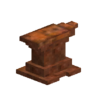
| |
| Material | Metalle |
| Stackable | Nein |
| Drops | sich Selbst |
| Blocks | |
Ambosse sind funktionale Blöcke, die beim Schmieden von Metall als Oberfläche genutzt werden.
Herstellung
Kupfer und Bronze Amboss
Der erste Schritt in diesem Prozess ist, eine Ambossform mit Hilfe der Methode des Lehmformens herszustellen. Der Amboss wird dann gegossen. Ein Amboss benötigt 900 Einheiten (9 Barren) Kupfer oder Bronzelegierung, um die Form zu füllen. Sobald ein Amboss gegossen und aus der Form entfernt wurde, kann er wie jeder andere Block auf einer festen Oberfläche platziert werden. Es wir kein Werkzeug benötigt, um den Amboss aufzunehmen und neu zu positionieren.
In the game, you will need a Tier (n-1) anvil to work Tier (n) materials, i.e. you will need a bronze (Tier 2) anvil to work iron (Tier 3) ingots.
Copper (Tier 1) and Bronze (Tier 2) Anvil
The first step in this process is to create an anvil mold via the clay forming mechanic. The anvil is then cast using the casting mechanic. An anvil requires 900 units (9 ingots-worth) of copper or bronze alloy to fill the mold. Once an anvil is cast and removed from the mold, it may be placed like any other block onto a solid surface. No tools are required to break an anvil to pick it up and re-position it.
Amboss aus Eisen und Meteoreisen
Amboss aus Eisen oder Meteoreneisen können nicht wie Ambosse aus anderen Metallen gegossen werden. Der Spieler muss zuerst Ober- und Unterteil separat auf einem Bronzeamboss schmieden. Dann müssen beide Teile zusammen geschweißt werden.
Um einen kompletten Eisenamboss herzustellen, werden insgesamt 10 Eisenbarren benötigt (je 5 Barren für Ober- und Unterteil) sowie einmal Boraxpulver. Ein Barren ergibt 42 zusätzliche Pixel. Das Ober- und Unterteil des Ambosses benötigen 210 respektive 196 Pixel.
Anvils made out of iron or meteoric iron cannot be cast in molds like copper and bronze anvils, since iron and meteoric iron cannot be melted in a crucible. The player first has to make the upper and lower parts of the anvil separately, smithing them with any hammer on a bronze anvil. Then, the two parts need to be welded together with powdered borax.
To make a complete iron anvil, a total of 10 iron ingots are needed, 5 each for the anvil base and anvil top, as well as one powdered borax. One ingot amounts to 42 voxels added, and the anvil base and top need 196 and 210 voxels respectively.
Protip:
Das Rezept hat eine maximale Höhe für die Pixel. Diese bedeutet, dass beim Hinzufügen zu vieler Barren auf einmal (ohne Verarbeitung der vorherigen Barren) einige Pixel gelöscht werden können. Stelle sicher, dass du den nächsten Barren erst nach der Verarbeitung des letzten Barrens hinzufügst. |
Ambossbasis
Beginne den Herstellungsprozess, indem du einen erhitzten Eisenbarren auf dem Amboss (Bronze oder höherstufig) platzierst. Wähle die Ambossbasis und beginne zu hämmern. Beachte, dass für die Basis insgesamt 5 Barren nötig werden und nur Raum für Fehler von 14 Pixeln besteht. Dieser Prozess kann leichter sein, wenn mit einer Eisenplatte begonnen wird und dann nacheinander 3 weitere Barren hinzugefügt werden.
Um die Gefahr der Verschwendung von Pixeln (und damit Barren) zu reduzieren, muss nach dem Hinzufügen eines Barrens dieser zuerst geschmiedet werden, bevor der nächste Barren folgt usw. Der Punkt, an dem der nächste Barren hinzugefügt wird, ist immer der gleiche. Daher kann der Spieler sicherstellen, dass dieser Bereich eben und unterhalb der maximalen Höhe des Rezeptes bleibt (6 Pixel bzw. 3 gestapelte Barren). Behalte im Kopf, dass ein neuer Barren nur die leeren Pixel an der genannten Stelle ausfüllt. Daher empfiehlt es sich, diesen Bereich so eben wie möglich zu halten. Der Barren wird auf die gewählte Fläche oben aufgesetzt, sodass der gesamte Bereich "anwächst".
Ein optimaler Weg des Schmiedens kann unten angesehen werden, wobei der Fokus darauf liegen sollte, dass die "Landefläche" des Barren so leer und eben ist wie möglich. Denk daran, dass dies der beste Weg ist, um Eisenbarren zu sparen, aber nicht um Kohle zu sparen.
Start the crafting process by placing a heated iron ingot on the anvil - bronze or higher anvil tier is needed. Select the anvil base and start hammering. Note that for the base, a total of 5 ingots need to be added, and there is at maximum 14 voxels worth room for error. This process might be easier when starting with one iron plate as the base, and then adding 3 more ingots, one at a time.
To lessen the chance of wasting voxels - and thus ingots - it is necessary to add one ingot, flatten it out and only then add the next - and so forth. The space on which the next ingot will be added is always the same, and the player can make sure that this space is flat and below the maximum height limit of the recipe, which is 6 voxels, or 3 ingots stacked. Keep in mind that a new ingot added will only fill in the empty voxels in that specific space, so it is recommended to keep the ingot place as flat as possible. The ingot will however rise with the rest, meaning it will be added on top of the current surface.
An optimum way of smithing can be seen below, with the focus on keeping the "ingot landing space" as empty and flat as possible. However, keep in mind that this is the best way to save iron ingots, not the best way to save coal.
Protip:
You do not need to leave space around the anvil to go behind to work on the back part of the item. Just do a right mouse click with the hammer in hand and the item you are working on will rotate. |
Der Amboss benötigt insgesamt 196 Pixel, aufgeteilt in 5 Ebenen:
- 80 Pixel für die erste Ebene
- je 38 Pixel für die zweite und dritte Ebene
- je 20 Pixel für die vierte und fünfte Ebene
Oberteil des Ambosses
Für das Ambossoberteil ist der gleiche Ablauf nötig. Denk daran, dass für das Oberteil auch bei vorsichtigem Schmieden nicht ein Pixel zu viel vorhanden ist. Dies bedeutet, dass es keinen Platz für Fehler gibt, da ein verschwendeter Pixel in einem weiteren benötigten Barren (dem 6.) endet, um das Objekt zu vollenden. Da das Oberteil eher schmal ist, ist eine Platte als Basis nicht geeignet.
For the anvil top, follow the same process. However, keep in mind that for the top part, not even one voxel should be wasted. This means there is no margin for error, and any wasted voxels will result in a sixth ingot added to finish the item. As the top part is rather slim, a plate is not helpful as the smithing base.
Das Oberteil des Ambosses benötigt insgesamt 210 Pixel, aufgeteilt in 5 Ebenen:
- 78 Pixel für die erste Ebene
- 48 Pixel für die zweite Ebene
- 40 Pixel für die dritte Ebene
- 24 Pixel für die vierte Ebene
- 20 Pixel für die fünfte Ebene
Schweißen
Nachdem Basis und Oberteil fertigestellt wurden, erhitze beide in der Schmiede. Sobald erhitzt, platziere zuerst die Basis auf den Boden. Nimm einen Teil Boraxpulver und füge es hinzu, dann setze das Oberteil darauf. Hämmere, bis beide Teile zusammengefügt sind. Dies sollte 12 Treffer benötigen.
After both the base and top are finished, heat both of them up in a forge. Once heated, first place the base part down on the ground. Take one portion of powdered borax and apply with a Shift+right click on the placed base, then add the top part. Hammer until both parts are welded together, this should take about 12 hits.
Verwendung
Der Amboss ist eine Arbeitsfläche, um metallische Werkzeuge aus in einer Schmiede erhitzten Barren zu schmieden. Wenn ein erhitzter Barren auf dem Amboss platziert wird, öffnet sich eine Dialogbox, die dem Spieler die Auswahl des herzustellenden Objektes erlaubt. Kupfer- und Bronzeobjekte können auf jedem Amboss bearbeitet werden, aber Eisenobjekte benötigen einen Bronze- oder Eisenamboss und Stahlobjekte können nur auf einem Eisenamboss bearbeitet werden.
The anvil is the work surface used for smithing metal tools from ingots heated in a forge. When a heated ingot is placed on the anvil, a dialog box opens to allow the player to select the item to be crafted. Copper and Bronze items can be worked on any anvil, but iron items can only be worked on a bronze or iron anvil and steel items can only be worked on an iron anvil.
There is no need to craft steel anvils at this time, as there are no Tier 5 metals in the game.
Besonderes
Ein Amboss kann nicht geschmolzen werden, um das Material, aus dem das Objekt hergestellt wurde, zurückzuerhalten. Seit Version 1.14 kann der Spieler einen Meißel und einen Amboss aus dem gleichen Metall im Herstellungsmenü kombinieren, um 8 Metallbarren zurückzugewinnen. Denk daran, dass Amboss und Meißel beide bei diesem Prozess zerstört werden. Dies bedeutet, dass von den ursprünglichen 10 Barren insgesamt 2 Barren dauerhaft zerstört werden.
Seit Version 1.14 verursachen fallende Ambosse beachtlichen Schaden, wenn sie einen Spieler oder andere Kreatur treffen.
An anvil cannot be smelted to recover the material used in creating the item, however since version 1.14, the player can use a chisel and anvil of the same metal type in the crafting grid to recover 8 ingots worth of metal. Keep in mind that both the anvil and the chisel will be destroyed in the process, meaning from the original 10 ingots, two will be permanently lost.
Since version 1.14, falling anvils do considerable damage when hitting a player or other entity.
Video Anleitungen
| Detaillierte Anleitung über den Herstellungsprozess eines Eisenambosses (Englisch) |
|---|
| Detailed guide through the iron anvil smithing process |
|---|
History
Notes
- While the metal tier matters for the anvil, it doesn't matter for the hammer or helve hammer.
- A copper hammer may be used to smith a steel ingot. But higher tiers are preferable for their higher durability (more uses before breaking).
- A bronze helve hammer may be used to smith a steel ingot. Helve hammers have no durability, and there's no reason to prefer higher tier metals.
- Though iron and meteoric iron anvils are both tier 3, you need an iron anvil in order to smith meteoric iron ingots.
Gallery
See also
References
| Erze, Metalle und Mineralien | |
|---|---|
| Guides | Erzansammlungen • Metalle |
| Nützliche Metalle | Kupfer • Eisen • Meteor Eisen • Gold • Silber • Blei • Zinn • Zink • Bismuth • Titanium (Ilmenite) • Nickel |
| Nützliche Legierungen | Bronze (Zinnbronze, Bismuthbronze, Schwarzbronze) • Stahl • Messing • Lötkolben (Lötkolben aus Blei, Lötkolben aus Silber) • Molybdochalkos • Cupronickel • Electrum |
| Mineralien | Alaun • Borax • Zinnober • Kohle • Halit (Salz) • Lapislazuli • Quarz • Salpeter • Schwefel • Pottasche |
| Werkzeuge | Spitzhacke • Hammer • Geologenhammer • Crucible • Schmiede • Ore blasting bomb • Handmühle • Amboss • Hochofen • Stielhammer • Pulverisierer |
| Sonstiges | Edelsteine |
| Related mechanics | Schürfen • Erzabbau • Clay forming • Metallgießen • Schmieden • Stahl Herstellung |
| Wiki Navigation | |
|---|---|
| Vintage Story | Guides • Frequently Asked Questions • Soundtrack • Versions • Controls |
| Game systems | Crafting • Knapping • Clay forming • Smithing • Cooking • Temperature • Hunger • Mining • Temporal stability • Mechanical power • Trading • Farming • Animal husbandry |
| World | World generation • Biomes • Weather • Temporal storms |
| Items | Tools • Weapons • Armor • Clothing • Bags • Materials • Food |
| Blocks | Terrain • Plants • Decorative • Lighting • Functional • Ore |
| Entities | Hostile entities • Animals • NPCs • Players |
| Miscellaneous | List of client commands • List of server commands • Creative Starter Guide • Bot System • WorldEdit • Cinematic Camera • Adjustable FPS Video Recording • ServerBlockTicking |
